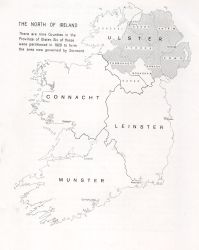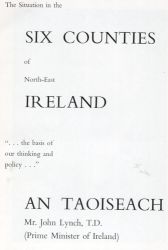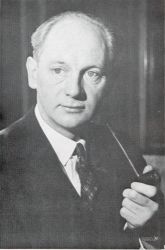
Lynch, Jack. (1969) 'The Situation in the Six Counties of the North-East Ireland'. Dublin: Irish Government.[Key_Events] [Key_Issues] [CONFLICT_BACKGROUND] BACKGROUND: [Acronyms] [Glossary] [NI Society] [Articles] [Chronologies] [People] [Organisations] [CAIN_Bibliography] [Other_Bibliographies] [Research] [Photographs] [Symbols] [Murals] [Posters] [Maps] [Internet] PDF Version [4048KB] also available.
AN TAOISEACH
I would like in clear and simple terms to set out the basis of our thinking and policy. I hope that this will help to reduce those tensions in the North which arise from misunderstandings or apprehensions about our attitude or intentions. The historical and natural unity of Ireland was also a political unit until this was artificially sundered by the Government of Ireland Act passed by the British Government in 1920. The Act, in effect, provided for the partitioning of Ireland and the creation of a Government of Northern Ireland subordinate to Westminster. Partition was not expected to be permanent even by the authors of this statute - the ultimate aim of "one Parliament and one Government for the whole of Ireland" appeared in the official summary of the Bill preceding this legislation and provision was made for a Council of Ireland which, according as powers were transferred to it by the two parts of Ireland, might develop into an All-Ireland Parliament. Mr. Asquith, former British Prime Minister said: "Ireland is a nation; not two nations, but one nation. There are few cases in history, and as a student of history in a humble way, I myself know none, of a nationality at once so distinct, so persistent, and so assimilative as the Irish". Mr. Winston Churchill once said: "Whatever Ulsters right may be, she cannot stand in the way of the whole of the rest of Ireland. Half a province cannot impose a permanent veto on the nation. Half a province cannot obstruct forever the reconciliation between the British and the Irish democracies and deny all satisfaction to the united wishes of the British Empire". King George V. speaking in Belfast at the opening of the Northern Ireland Parliament in June 1921, hoped that the opening would be: "the prelude of the day in which the Irish people, North and South, under one Parliament or two, as those Parliaments may themselves decide, shall work together in common love for Ireland upon the sure foundation of mutual justice and respect". I need not explain or justify the fundamental desire of the overwhelming majority of the people of this island for the restoration in some form of its national unity. This desire is not confined to Irishmen of any particular creed or ancestry. I want to make it clear, however, once more, that we have no intention of using force to realise this desire. I said as recently as 28th August that it was and has been the Governments policy to seek the re-unification of the country by peaceful means. The unity we seek is not something forced but a free and genuine union of those living in Ireland based on mutual respect and tolerance and guaranteed by a form or forms of government authority in Ireland providing for progressive improvement of social, economic and cultural life in a just and peaceful environment. Of its nature this policy - of seeking unity through agreement in Ireland between Irishmen - is a long-term one. It is no less, indeed it is even more, patriotic for that. Perseverance in winning the respect and confidence of those now opposed to unity must be sustained by good-will, patience, understanding and, at times, forbearance. The terrible events of the past few months have made it evident to all that, apart from disrupting the unity of Ireland, the 1920 devolution of powers has not provided a system of Government. acceptable as fair and just, to many of the people in Northern Ireland. I need not detail these events nor refer to recent objective appraisals of that system of government. But change there obviously must be. We are concerned that the grievances of so many of our fellow Irishmen and women be quickly remedied and their fears set at rest. We also have a legitimate concern regarding the disposition to be made by the British Government in relation to the future administration of Northern Ireland. Our views on how peace and justice can be assured in this small island are relevant and entitled to be heard. Let me make it clear, too, that in seeking re-unification, our aim is not to extend the domination of Dublin. We have many times down the years expressed our willingness to seek a solution on federal lines and in my most recent statement I envisaged the possibility of intermediate stages in an approach to a final agreed solution. Whatever the constitutional setting might be - and we are prepared to explore all the possibilities in constructive discussion - the united Ireland we desire is one in which there would be a scrupulously fair deal for all. The Protestants of the North need have no fear of any interference with their religious freedom or civil liberties and rights. Differences in political outlook or religious belief need not set people apart. They exist in most countries and are no barrier to effective and constructive cooperation of thc various elements in the community in national development. Indeed, diversity of cultural background can exert a stimulating influence. The real barriers are those created by fear, suspicion and intolerance. Every responsible person must hope that early and adequate reforms will bring peace and security to the people of the North of Ireland so that they may live together in neighbourliness without fear, sharing fairly in improving social and economic conditions, and with fading memories of past dissensions. It will remain our most earnest aim and hope to win the consent of the majority of the people in the Six Counties to means by which North and South can come together in a re-united and sovereign Ireland earning international respect both for the fairness and efficiency with which it is administered and for its contribution to world peace and progress. Finally, a few words on recognition. It is quite unreasonable for any Unionist to expect my Government, or any future Government, to abandon the belief and hope that Ireland should be reunited. It is unnecessary to repeat that we seek reunification by peaceful means. We are not seeking to overthrow by violence the Stormont Parliament or Government but rather to win the agreement of a sufficient number of people in the North to an acceptable form of reunification. In any case the Stormont Government, being the executive instrument of a subordinate Parliament, cannot receive formal international recognition. It is also, for similar reasons, unreasonable and unnecessary to expect those living in the Six Counties who share our desire for unity to renounce their deepest hopes. We and they have accepted as a practical matter the existence of a government in the North of Ireland exercising certain powers devolved on it by the British Parliament. We have had many fruitful contacts with that Government in matters of mutual concern. I hope that this cooperation between North and South will continue. May I conclude by referring to the words of Lord Craigavon, the first Prime Minister of Northern Ireland, when he said: "In this island, we cannot live always separated from one another. We are too small to be apart or for the Border to be there for all time".

|
CAIN
contains information and source material on the conflict
and politics in Northern Ireland. CAIN is based within Ulster University. |
|
|
|||
|
Last modified :
|
||
|
| ||

